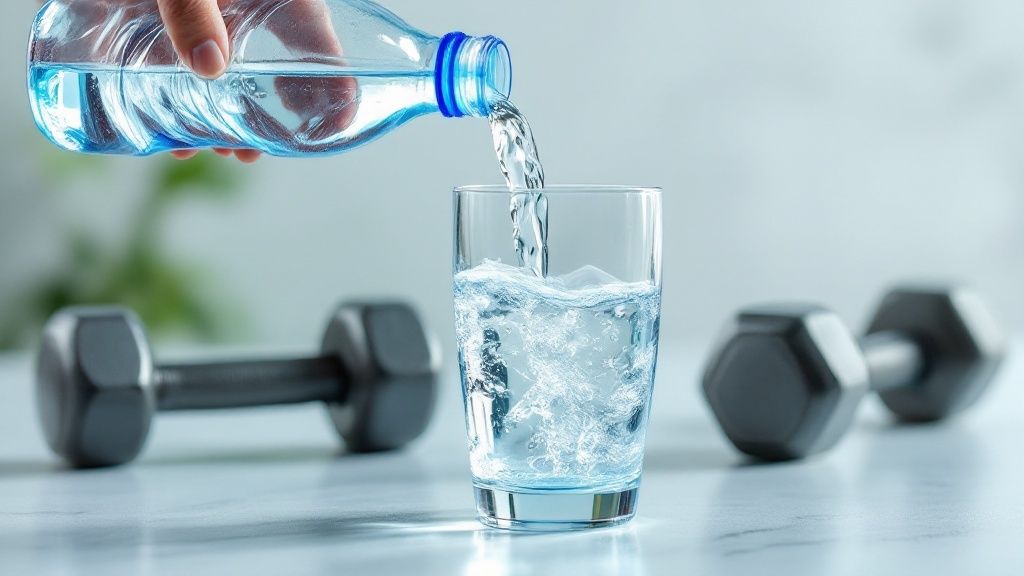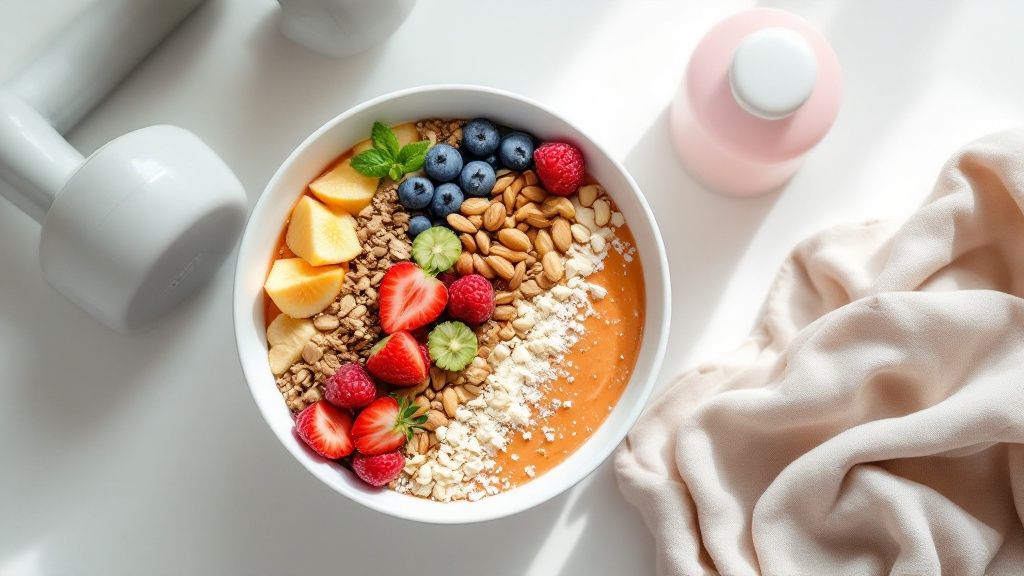How to Prevent Muscle Soreness: Top Tips for Faster Recovery
- Flourish Everyday Health And Fitness

- Oct 4
- 10 min read
Updated: Oct 9
We’ve all been there. That deep, satisfying ache after a tough workout feels like a badge of honor, but when it morphs into serious pain, it can completely sideline your fitness routine. This isn't about eliminating that feeling of "I worked hard," but about preventing the kind of debilitating soreness that kills your consistency.
The "How to Prevent Muscle Soreness: Top Tips for Faster Recovery" guide offers a practical, science-backed blueprint for preventing muscle soreness that goes beyond the usual "drink more water" advice.

Index
Your Blueprint for Preventing Muscle Soreness
It all starts with understanding what’s really going on in your body. That pain you feel a day or two after a workout has a name: Delayed Onset Muscle Soreness (DOMS). This is the official term for the muscle pain that typically peaks 12 to 48 hours after you’ve really pushed yourself.
DOMS is caused by microscopic tears in your muscle fibers—which is actually a normal part of the muscle-building process. Your body responds by rushing fluid to the area to start repairs, and that process leads to the familiar stiffness and discomfort (1).
The goal isn't to eliminate all feedback from your muscles, but to prevent the kind of pain that keeps you on the sidelines. Managing soreness is key to consistency.
The Five Pillars of Prevention
Effective soreness prevention rests on five core principles that work together. Weaving these into your routine builds a powerful defense against excessive post-workout pain.
Dynamic Warm-Up: Prepare your muscles for work by increasing blood flow and firing up your nervous system. Think leg swings, arm circles, and torso twists.
Strategic Hydration: Water is crucial. It helps transport nutrients to your muscles and flushes out metabolic waste products that contribute to soreness.
Targeted Nutrition: Give your body the raw materials it needs to repair itself, providing protein for repair and carbohydrates for fuel replenishment.
Active Recovery: Gentle movement on rest days boosts circulation, helping clear out soreness-causing byproducts while delivering fresh, oxygenated blood to tired muscles.
Quality Sleep: Sleep is when your body maximizes the release of growth hormone, a critical player in muscle repair and inflammation control.
To make this even simpler, here's a quick reference table that breaks down these core strategies.
Core Strategies for Muscle Soreness Prevention
Strategy | What It Does | When to Do It |
|---|---|---|
Dynamic Warm-Up | Increases blood flow and prepares muscles for activity. | Before every workout. |
Hydration | Flushes out waste products and transports nutrients. | Consistently, throughout the day. |
Nutrition | Provides protein for repair and carbs for energy. | Post-workout and in daily meals. |
Active Recovery | Boosts circulation and aids in muscle repair. | On rest days. |
Quality Sleep | Maximizes growth hormone for tissue repair. | Every night, aiming for 7-9 hours. |
This framework gives you the foundational strategies you need to make your fitness journey more consistent and enjoyable. When you can bounce back faster, you can train smarter and keep making progress without unnecessary downtime.

Using Nutrition and Hydration to Fight Soreness
What you put into your body before and after the gym is as important as the workout itself. Think of your muscles as a construction site; after a tough session, they need the right raw materials to rebuild stronger.
Your body needs protein to repair muscle tears and carbohydrates to restock energy (glycogen). Skimping on either will slow your recovery and worsen next-day soreness.
Timing Your Fuel for Optimal Repair
The "anabolic window" right after you exercise is prime time for refueling. Getting a mix of protein and carbs into your system within an hour or two post-workout kickstarts the repair process.
A simple, effective post-workout meal could be:
A scoop of whey protein blended with a banana.
Greek yogurt with berries and honey.
Grilled chicken breast alongside a sweet potato.
The goal is to give your muscles easily accessible nutrients so they can rebuild right away. For a deeper look at meal timing, check out our **guide to pre- and post-workout nutrition for maximum results**.
The Power of Anti-Inflammatory Foods
Beyond macros, certain foods have natural anti-inflammatory properties that can actively fight soreness.
Key Takeaway: You can literally eat your way to less soreness. Foods packed with antioxidants and anti-inflammatory compounds help your body manage the inflammation that causes muscle pain.
Some of the heaviest hitters include:
Tart Cherries: Studies have shown that tart cherry juice can significantly cut down on muscle pain and strength loss after a tough workout (2).
Turmeric: The active ingredient, curcumin, is a powerhouse anti-inflammatory.
Fatty Fish: Salmon, mackerel, and sardines are loaded with omega-3 fatty acids, famous for their inflammation-fighting abilities.
Nutritional strategies are becoming recognized for easing DOMS. Research points to compounds like omega-3s and polyphenols as being able to reduce soreness, with effects often kicking in during the 24 to 48-hour window when DOMS is at its worst.
Why Hydration Is a Non-Negotiable
Hydration is the unsung hero of muscle recovery. Water is crucial for getting nutrients to your cells and flushing out metabolic waste that builds up during exercise. Even slight dehydration can concentrate these waste products, making muscles feel more sore. Sip water all day, not just when you’re sweating. A pro tip is to weigh yourself before and after a hard session. For every pound you lose, aim to drink about 16-24 ounces of fluid to rehydrate properly.

Rethinking Your Warm-Up and Cool-Down Routine
A solid warm-up is your first line of defense, preparing your muscles to perform and resist damage. The key is dynamic stretching, active movements that get your body ready for work. They increase blood flow, raise core temperature, and prime the exact movement patterns you’ll be using.
Priming Your Muscles for Action
Mimicking workout movements at a lower intensity tells your muscles and nervous system what’s coming.
For example, before lifting weights, try:
Leg Swings: Opens up hips and wakes up hamstrings.
Arm Circles: Prepares shoulder joints.
Bodyweight Squats: Gets glutes, quads, and core firing.
For a run, walking lunges or high knees will do the trick. To dive deeper into improving your functional range of motion, our article on **what mobility training can do to boost your performance** is a great start.
The Truth About the Cool-Down
The cool-down's main job is to gently bring your heart rate and breathing back to normal. A slow jog or a casual walk for five to ten minutes is perfect. What about static stretching—holding a stretch for 20-30 seconds? Its role in preventing muscle pain is often overstated.
While stretching is fantastic for long-term flexibility, science shows its direct impact on next-day soreness is minimal. Think of it as one small piece of the recovery puzzle, not the whole picture.
Research is clear that stretching before or after a workout has a surprisingly small effect on soreness. A major meta-analysis found that stretching only reduced muscle soreness by about 2% in the 72 hours after exercise (3). The takeaway? Stretching is a tool, but it shouldn't be your only strategy for fighting DOMS.

Advanced Recovery Methods That Deliver Real Results
When your usual cool-down isn't enough, it’s time for advanced recovery methods. One of the most powerful tools is massage therapy. A good massage boosts circulation, helping flush out metabolic waste while delivering oxygen and nutrients your muscles need to repair.
A deep tissue massage is one of the most effective ways to head off muscle soreness. A meta-analysis confirmed that massage consistently dials down the intensity of DOMS and fatigue, outperforming methods like stretching or compression wear (4).
Self-Myofascial Release With Foam Rolling
Since a professional massage isn't always practical, a foam roller is your next best friend. This practice, known as self-myofascial release, lets you apply deep, targeted pressure to your muscles to break up knots and ease tension. After a heavy squat day, slowly roll over quads and glutes for 30-60 seconds each to help restore blood flow and range of motion. Go slow, pause on tender spots, and breathe to help the muscle release.
Comparison: Foam Rolling vs. Cryotherapy
Foam Rolling: Focuses on mechanical release of muscle fascia. It's accessible, affordable, and targets specific muscle knots. Best for immediate post-workout use to reduce stiffness.
Cryotherapy (Cold Therapy): Involves exposing the body to extremely cold temperatures for a short period. It aims to reduce systemic inflammation and muscle metabolism. While some athletes swear by it for rapid recovery, scientific evidence is still emerging and it is less accessible than foam rolling.
Leveraging Temperature and Pressure
Contrast Water Therapy: Alternating between hot and cold water. Try one minute cold followed by two minutes warm, repeating for 10-15 minutes. The switch from vasoconstriction to vasodilation creates a "pumping" action that helps flush out metabolic byproducts.
Compression Wear: Slipping into compression garments after a workout applies gentle pressure, supporting your circulatory system to reduce swelling and clear waste more efficiently.
The real magic of these advanced techniques is how they supercharge your body's natural healing processes. They help your body recover faster on a cellular level.

The Hidden Power of Sleep and Active Recovery
Two of the most powerful tools for fighting muscle soreness are free: sleep and active recovery. They work behind the scenes to repair tissue and flush out metabolic waste. Many people obsess over training and nutrition but treat sleep as an afterthought. Deep sleep is when your body releases a surge of human growth hormone (HGH), which is essential for repairing microscopic muscle tears and controlling inflammation.
Getting Your Sleep Dialed In for Better Recovery
Skimping on quality sleep short-circuits your recovery. Improving sleep hygiene is a direct investment in your physical performance.
A few simple tweaks can make a world of difference:
Stick to a Routine: Go to bed and wake up around the same time daily.
Create the Perfect Cave: Keep your bedroom cool (around 65°F / 18°C), dark, and quiet.
Power Down: Put away all devices at least an hour before bed.
Think of sleep as the final, most crucial rep of your workout. It’s when all that hard work actually turns into stronger, more resilient muscle.
Why Your Rest Days Should Still Involve a Little Movement
Instead of being sedentary, embracing active recovery can dramatically speed up healing and reduce soreness. Active recovery is low-intensity movement that gets your blood flowing without putting more stress on your muscles. This gentle activity acts like a pump for your circulatory system, delivering fresh, oxygen-rich blood to tired muscles while helping clear out metabolic byproducts like lactate.
Some great active recovery options are:
A brisk walk or a light jog
A casual swim
A gentle yoga or stretching session
A relaxed bike ride
Common Questions About Muscle Soreness
Getting a better handle on the different kinds of aches and pains will help you make smarter calls on your training and recovery.
How Do I Know if It Is Soreness or an Injury?
The answer comes down to what the pain feels like. DOMS is a dull, spread-out ache across the muscle that peaks 24 to 48 hours post-workout and then fades. An injury is often a sharp, specific pain that appears suddenly during a movement.
Other red flags for injury include:
Obvious swelling or bruising in one spot.
A noticeable drop in strength or inability to bear weight.
Pain that gets worse over days instead of better.
If the pain is sharp or stops you from doing daily activities, get it checked out by a professional.
Should I Use Ice or Heat for Sore Muscles?
Ice and heat are great tools for different jobs.
Think of it this way: ice for immediate damage control, and heat for soothing stiffness later on.Ice is for right after a brutal workout or a suspected tweak. It constricts blood vessels to reduce inflammation. Heat is for general muscle tightness that has already settled in. A warm bath or heating pad increases blood flow to relax tight muscles.
Can I Work Out When I Am Still Sore?
If it’s a mild ache, light activity or training a different muscle group is fine (active recovery). But if you're so sore it's messing with your range of motion, rest. Pushing through severe muscle damage increases injury risk and slows healing. Listen to your body.
Are BCAA Supplements Worth It for Soreness?
The science behind Branched-Chain Amino Acids (BCAAs) and their effect on soreness is mixed. They might offer a slight edge if your protein intake is low, but the effect is minimal for most. Your first defense should be high-quality protein from food. Supplements with more solid backing, like creatine and whey protein, will indirectly do more to help manage soreness long-term.
Top Athletic Shoe Reviews
The right footwear is a crucial, often overlooked component of preventing muscle soreness. Proper shoes provide support, absorb impact, and promote correct biomechanics, reducing the stress on your muscles and joints.
For Women:
Hoka Clifton 9: Known for its maximalist cushioning, this shoe is excellent for long-distance runners or anyone needing superior shock absorption. The plush feel minimizes impact forces, which can lead to less soreness in the shins and calves.
Brooks Ghost 15: A versatile, neutral daily trainer that offers a perfect balance of softness and responsiveness. It's a workhorse shoe ideal for varied workouts, providing reliable support that helps prevent foot and leg fatigue.
For Men:
Nike Pegasus 40: A legendary all-rounder, the Pegasus provides a snappy, responsive feel thanks to its Zoom Air units. It's great for runners who want a shoe that feels fast but still offers enough cushioning to protect muscles during daily training runs.
New Balance Fresh Foam X 880v13: This shoe is the definition of a reliable daily trainer. Its Fresh Foam X midsole is engineered for a soft yet stable ride, making it suitable for high-mileage weeks and helping to reduce accumulated muscle strain.
References
Cheung K, Hume P, Maxwell L. Delayed onset muscle soreness : treatment strategies and performance factors. Sports Med. 2003;33(2):145-64. doi: 10.2165/00007256-200333020-00005.
Kuehl KS, Perrier ET, Elliot DL, Chesnutt JC. Efficacy of tart cherry juice in reducing muscle pain during running: a randomized controlled trial. J Int Soc Sports Nutr. 2010;7:17. Published 2010 May 7. doi:10.1186/1550-2783-7-17.
Herbert RD, de Noronha M, Kamper SJ. Stretching to prevent or reduce muscle soreness after exercise. Cochrane Database Syst Rev. 2011;(7):CD004577. Published 2011 Jul 6. doi:10.1002/14651858.CD004577.pub3.
Guo J, Li L, Gong Y, et al. Massage Alleviates Delayed Onset Muscle Soreness after Strenuous Exercise: A Systematic Review and Meta-Analysis. Front Physiol. 2017;8:747. Published 2017 Sep 27. doi:10.3389/fphys.2017.00747.
At Flourish-Everyday, we believe that the right gear and knowledge are key to a consistent and enjoyable fitness journey. Explore our expert reviews on the best cross-training and running shoes to support your every move. Find your perfect pair and elevate your training today.


Comments